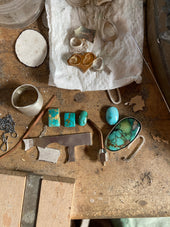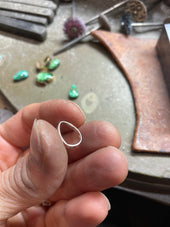See the previous blog post here if you want to read the first steps in making a piece of jewelry!
.
The next steps in making a piece of jewelry with a bezel-set stone involve soldering on the backplate that goes behind the bezel. Depending on the project, I select a backplate thickness of 24-18 gauge metal. In this example pictured below, I am using 22 gauge 14k goldfill double-clad sheet (meaning a layer of 14k gold covers both sides of the metal).
.

.
An important part of metalsmithing is efficiently using materials--because they are precious metals after all--so you'll notice the irregular shape of the metal I'm making the backplate out of. I hardly scrap any metal because I plan how I use my sheet so that as much as possible ends up in finished jewelry. A lot of jewelers cut squares of silver to solder their bezels onto, but I find that that leaves unnecessary waste. It is not actual waste, as it can be melted and re-fabricated or sent to a refiner for credit/cash. However, for me it's no hassle to solder bezels onto oddly shaped bits of sheet metal as long as they fit the end design I'm going for.
.
Oh a little detail: I use my maker's mark to stamp "LUMENROSE" onto the back before setting up the bezel to solder it all together.
.

.
Now on to soldering. I check that the bezel is fully contacting the backplate. I might tap the top of the bezel with a hammer to flatten the whole thing if needed. This is important so that the solder seam is strong. I place 4 small pieces of medium gold wire solder inside the bezel so that they touch both the backplate and the bezel wall. For goldfill I have found that heating the piece from above first, then picking it up with tweezers and heating from below is the best way to flow the solder evenly. Make sure to use flux! Goldfill is more finicky to work with than sterling in my opinion. It is less forgiving during the polishing phase as it is easy to accidentally polish off the 14karat gold layer entirely, leaving the brass core exposed.
.

.
After checking that the solder has flowed entirely around the base of the bezel making a solid connection, I drop it in the pickle pot. See the previous blog post for what that's all about. After 15 minutes or more (I uses citric acid pickle solution and that takes longer than other acids), I take the piece out, rinse and dry it, then it's ready to be cut into the final shape.
.
Using a jeweler's saw I cut out the shape of the backplate. I then file it smooth with a hand file and make sure the visible metal border around the bezel is even all around the stone.
.

.
I use an abrasive wheel on my flex shaft (an essential rotary tool that holds a million kinds of bits/burs/wheels to grind/clean/polish) to smooth everything out. The last soldering step in this particular project is to solder on a jump ring so that it can hang as a necklace pendant.
.

.
As you can see, post -soldering the piece is in quite a dirty state. After another pickle bath to clean it up, I am ready to set the stone. Check out this Instagram reel for how I set the stones on pieces like this. Once the stone is secure, to achieve the final polished look I go through about 3 levels of abrasive polishing wheels and a final buffing (all with my flex shaft...somehow I am a jeweler who has hardly ever used and does not own a polishing machine aka bench lathe). Now the piece is shiny and ready for a chain.
.
Here it is with the chain added. Each necklace I make has a handmade clasp and a soldered jump ring. This necklace will be listed in the shop this week. If you'd like to inquire about it before then just send an email to lumenrosejewelry@gmail.com, or be sure you're signed up for the email list to get notified when I update the shop. There will be a few little pendants and some Lumenrose Hoops. You can sign up by scrolling to the very bottom of this page and entering your email in the box on the right.
.

.
I hope this gives a little bit of insight into the process of making a simple bezel-set stone pendant!



